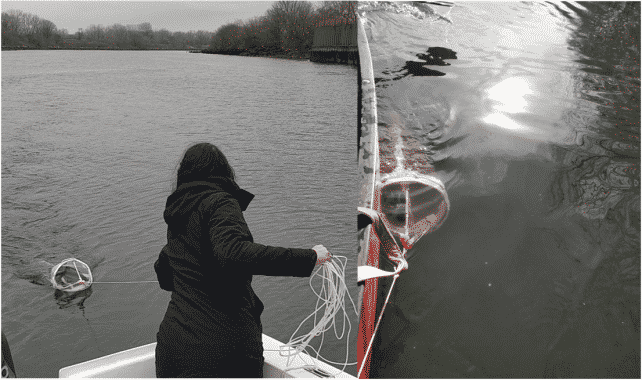
A blue microfiber (microscopic fiber) next to a human eyelash.
What are microplastics?
By now, most of us are aware that plastic takes hundreds or thousands of years to completely breakdown. Images of plastic bags and bottles littering beaches and public areas are very visible in the news these days. However, invisible to the naked eye and of increasing concern are microplastics, tiny (<5 mm) pieces of plastic that are too small to be captured by water treatment facilities. Consequently, they flow unimpeded into our rivers and oceans. Microplastics can originate from many sources, including every-day items and even laundry. While many researchers around the world are focusing on the effects of microplastics on the world’s oceans, the effects on rivers and freshwater systems are less well understood.
That changed for the Bronx River when we successfully completed our Microplastics Pilot Study in March 2020. Up to this point, the Project WASTE protocol had only addressed waste on a macro level (things we can see with the naked eye.) The Bronx has a large and active fishing community that uses the Bronx River and Long Island Sound as a food source (though we do not encourage this due to the associated health risks). The Bronx River is also the site of extensive ecological restoration efforts, including an annual native fish restocking and a new oyster reef. It is possible that microplastic pollution could be threatening our communities and our restoration efforts. Therefore, it is important that we understand as much about it as we can to determine how to protect the river and its ecosystems.
What work did we do?
In July 2019, our partners at Baykeeper and NJCU collected several mussels and oysters from Soundview Park to compare with oysters collected from a less-industrial location in New Jersey as well as store-bought oysters. They also performed several microplastic trawls (towing a net behind a boat) in the mouth of the Bronx River. With a cone-shaped net made of very fine mesh, they strained the river water to catch plankton and microscopic particles for analysis. They found that there were twice as many microplastic particles as live plankton in the mouth of the river, mostly tiny pieces of Styrofoam. The mussels and oysters contained small plastic fibers (microfibers), indicating that the animals are consuming plastic as they feed, though the ones from the Bronx River did contain less plastic than the ones from New Jersey and the supermarket. The results demonstrated the need to study more of the river to get a better understanding of this pollution.
Together with our colleagues at Rocking the Boat, we designed a method to collect, process, and analyze samples of water from the Bronx River for microplastics. While more sophisticated methods (such as NOAA’s) require the use of dangerous chemical reactions, our method is much simpler and can be done in a classroom. First, we trawled the river at three different locations with a plankton net. In the estuary this was done with a motorboat, in the Bronx Zoo it was done by canoe, and in the shallow waters of the upper river, this was done by hand while wading. As water passed through the net, microscopic particles (as well as larger detritus) were caught and funneled into a small bucket. After the trawls, the samples were thoroughly washed from the bucket and passed through a series of sieves (small metal screens, similar to a tea strainer.) Larger particles like leaves were caught on the largest sieve, while microscopic particles were caught on the smallest sieve. After washing the material off of the sieve and evaporating the water, the samples were stained with special dyes. Lighter samples with less material were stained with Rose Bengal, a dye that turns organic matter a dark pink, while dirtier samples were stained with Nile Red, a dye that caused the microplastic to glow under blue light. These stains helped us find and separate the microplastics from the other material under a microscope.

The trawl net is cast behind a motorboat.Trawling the Bronx River by canoe.

What did we find?
Unsurprisingly, we found a lot of microplastic pollution in all samples. The samples from the upper river contained lots of microfibers, while samples from the lower river contained lots of Styrofoam pieces. Also found were pieces of film (the remnants of plastic bags) and a few microbeads. Heavy samples (like the sample in the image below to the right) contained over 1,000 microplastic particles.

Microfibers cling to stained Microfibers collected from the Bronx Stained microplasic particles glowing in different organic material.

A researcher analyzing a sample with blue light.A stained particle viewed under an A stained particle viewed under LED light filtered blue light.
So, what next?
We proved that our methods could be used to successfully collect, process, and analyze river samples to determine the amount of microplastics present. In doing so, we have joined the Hudson River Park Trust, New York State Parks, and other organizations investigating this threat, this time in the only freshwater system in New York City. As we all are hyper aware of this issue, we highly encourage you to help by reducing your own plastic footprint.
